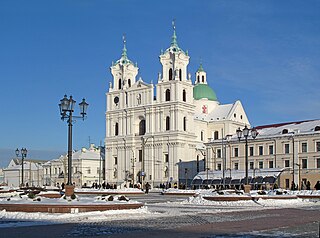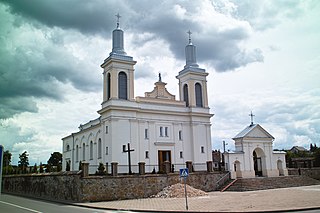| |||||
| Decades: | |||||
|---|---|---|---|---|---|
| See also: | |||||
Events from the year 1706 in Russia
| |||||
| Decades: | |||||
|---|---|---|---|---|---|
| See also: | |||||
Events from the year 1706 in Russia

| | This section needs expansion. You can help by adding to it. (July 2016) |

The Armed Forces of the Republic of Belarus consist of the Ground Forces and the Air Force and Air Defence Forces, all under the command of the Ministry of Defence of Belarus. As a landlocked country, Belarus has no navy.

The lands of Belarus during the Middle Ages became part of Kievan Rus' and were split between different principalities, including Polotsk, Turov, Vitebsk, and others. Following the Mongol invasions of the 13th century, these lands were absorbed by the Grand Duchy of Lithuania, which later was merged into the Polish–Lithuanian Commonwealth in the 16th century.

Hrodna or Grodno is a city in western Belarus. The city is located on the Neman River, 300 kilometres (190 mi) from Minsk, about 15 kilometres (9.3 mi) from the border with Poland, and 30 kilometres (19 mi) from the border with Lithuania. As of 2023, the city has a population of 358,717 inhabitants. Hrodna/Grodno serves as the administrative center of Hrodna/Grodno Region and Hrodna/Grodno District, though it is administratively separated from the district.

The Byelorussian Soviet Socialist Republic, also known simply as Byelorussia, was a republic of the Soviet Union (USSR). It existed between 1920 and 1991 as one of fifteen constituent republics of the USSR, with its own legislation from 1990 to 1991. The republic was ruled by the Communist Party of Byelorussia and was also referred to as Soviet Byelorussia or Soviet Belarus by a number of historians. Other names for Byelorussia included White Russia or White Russian Soviet Socialist Republic and Belorussian Soviet Socialist Republic.

Grodno Region, also known as Grodno Oblast or Hrodna Voblasts is one of the regions of Belarus. It is located in the western part of the country. Its administrative center, Grodno, is also the largest city in the region.

Mir is an urban-type settlement in Karelichy District, Grodno Region, Belarus. It is situated on the banks of Miranka River, about 85 kilometres (53 mi) southwest of the capital, Minsk.

The Battle of the Niemen River was the second-greatest battle of the Polish–Soviet War. It took place near the middle Neman River between the cities of Suwałki, Grodno and Białystok. After suffering almost complete defeat in the Battle of Warsaw, Mikhail Tukhachevsky's Red Army forces tried to establish a defensive line, against Józef Piłsudski's counter-attacking Polish Army, running northward from the Polish-Lithuanian border to Polesie, and centering on Grodno. Between September 15 and September 25, 1920, the Poles outflanked the Soviets, once again defeating them. After the mid-October Battle of the Szczara River, the Polish Army had reached the Tarnopol-Dubno-Minsk-Drissa line.

Vawkavysk or Volkovysk is a town in Grodno Region, Belarus, and the administrative center of Vawkavysk District. It is located on the Wolkowyja River, roughly 98 kilometres (61 mi) from Grodno and 271 kilometres (168 mi) from Minsk. As of 2023, it has a population of 41,991. It is one of the oldest towns in the region.

The Grodno Governorate was a governorate (guberniya) of the Northwestern Krai of the Russian Empire, with its administrative center in Grodno (Hrodna). The governorate encompassed 38,671.5 square kilometres (14,931.1 sq mi) in area and consisted of a population of 1,631,645 inhabitants by 1897. The Grodno Governorate bordered by the Suwałki Governorate to the north, the Vilna Governorate to the northeast, the Minsk Governorate to the east, the Volhynian Governorate to the south, the Kholm Governorate to the west, and the Łomża Governorate to the northwest. The governorate covered areas of the modern Grodno Region of Belarus, part of the Podlaskie Voivodeship of Poland, and a small part of Druskininkai, Lazdijai and Varėna districts.

The Battle of Grodno (1706) refers to the battle during the Great Northern War. Grodno was a city of the Polish–Lithuanian Commonwealth at this time.

The Old Grodno Castle originated in the 11th century as the seat of a dynasty of Black Ruthenian rulers, descended from a younger son of Yaroslav the Wise of Kiev.

The Grodno Ghetto was a Nazi ghetto established in November 1941 by Nazi Germany in the city of Grodno for the purpose of persecution and exploitation of Jews in Western Belarus.

Yanka Kupala State University of Hrodna/Grodno is а higher education institution located in Hrodna/Grodno. It is the largest regional higher education institution in the Republic of Belarus, university complex integrating all levels of education.

The First Battle of Grodno took place on 19 and 20 July 1920, during the Polish-Soviet War. In the effect of a three-day-long struggle for the control of the city of Grodno, the town was captured by Russian forces, despite repeated counter-attacks by Polish infantry, tanks and armoured trains.

The Battle of Kletsk took place on 30 April 1706, in- and outside the city of Kletsk, Belarus during Charles XII's Polish campaign of 1701–1706, in the Great Northern War. The Swedish forces were led by Carl Gustaf Creutz who defeated a larger Russian–Cossack force under the command of Semjon Nepljujev and Danylo Apostol. Many of the Russian and Cossack regiments participating in the battle were wiped out and ceased to exist as fighting units.

The 1704 Polish–Lithuanian royal election was an election to decide on the new candidate for the Polish–Lithuanian throne.
The Battle of Valkininkai took place at 6 March 1706 close to the town of Valkininkai in the Grand Duchy of Lithuania during the Great Northern War.
Battle of Valkininkai may refer to:
Ukrainians in Belarus comprise one of the largest ethnic minorities in Belarus, making up 1.7% of the population as of the 2009 census at 158,723 people. The largest concentration of Ukrainians is in Brest Region, where they make up 2.9% of the population. The largest share of Ukrainians in the country was recorded in Kamieniets, Brest, Kobryn, and Zhabinka districts.
![]() Media related to 1706 in Russia at Wikimedia Commons
Media related to 1706 in Russia at Wikimedia Commons